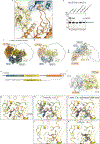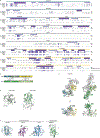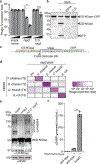An E1-E2 fusion protein primes antiviral immune signalling in bacteria
- PMID: 36755092
- PMCID: PMC10292035
- DOI: 10.1038/s41586-022-05647-4
An E1-E2 fusion protein primes antiviral immune signalling in bacteria
Erratum in
-
Author Correction: An E1-E2 fusion protein primes antiviral immune signalling in bacteria.Nature. 2023 Mar;615(7954):E25. doi: 10.1038/s41586-023-05931-x. Nature. 2023. PMID: 36914867 No abstract available.
Abstract
In all organisms, innate immune pathways sense infection and rapidly activate potent immune responses while avoiding inappropriate activation (autoimmunity). In humans, the innate immune receptor cyclic GMP-AMP synthase (cGAS) detects viral infection to produce the nucleotide second messenger cyclic GMP-AMP (cGAMP), which initiates stimulator of interferon genes (STING)-dependent antiviral signalling1. Bacteria encode evolutionary predecessors of cGAS called cGAS/DncV-like nucleotidyltransferases2 (CD-NTases), which detect bacteriophage infection and produce diverse nucleotide second messengers3. How bacterial CD-NTase activation is controlled remains unknown. Here we show that CD-NTase-associated protein 2 (Cap2) primes bacterial CD-NTases for activation through a ubiquitin transferase-like mechanism. A cryo-electron microscopy structure of the Cap2-CD-NTase complex reveals Cap2 as an all-in-one ubiquitin transferase-like protein, with distinct domains resembling eukaryotic E1 and E2 proteins. The structure captures a reactive-intermediate state with the CD-NTase C terminus positioned in the Cap2 E1 active site and conjugated to AMP. Cap2 conjugates the CD-NTase C terminus to a target molecule that primes the CD-NTase for increased cGAMP production. We further demonstrate that a specific endopeptidase, Cap3, balances Cap2 activity by cleaving CD-NTase-target conjugates. Our data demonstrate that bacteria control immune signalling using an ancient, minimized ubiquitin transferase-like system and provide insight into the evolution of the E1 and E2 machinery across domains of life.
© 2023. The Author(s), under exclusive licence to Springer Nature Limited.
Conflict of interest statement
Competing Interest
The University of Colorado Boulder and the University of California San Diego have patents pending for Cap2 and Cap3 technologies on which H.E.L., Q.Y., Y.G., K.D.C., and A.T.W are listed as inventors.
Figures













References
-
- Cohen D et al. Cyclic GMP-AMP signalling protects bacteria against viral infection. Nature 574, 691–695 (2019). - PubMed
Publication types
MeSH terms
Substances
Grants and funding
LinkOut - more resources
Full Text Sources
Research Materials

